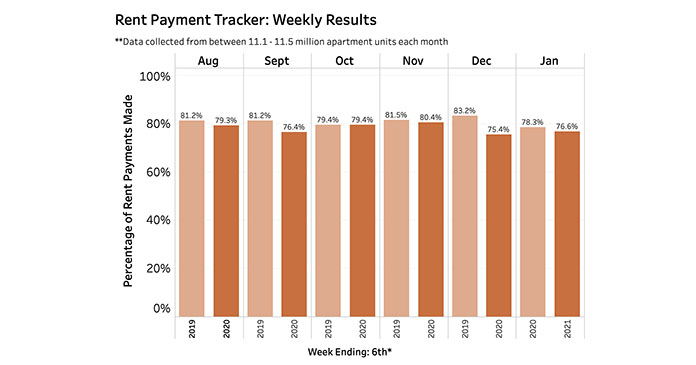The National Multifamily Housing Council (NMHC)’s Rent Payment Tracker found 76.6 percent of apartment households made a full or partial rent payment by January 6 in its survey of almost 11.3 million units of professionally managed apartment units across the country.
This is a 1.7 percentage point, or 192,613 household decrease from the share who paid rent through January 6, 2020 and compares to 75.4 percent that had paid by December 6, 2020. These data encompass a wide variety of market-rate rental properties across the United States, which can vary by size, type and average rental price.
“While there is light at the end of the tunnel with the rollout of vaccines, the country and the multifamily industry continue to face steep challenges,” said Doug Bibby, NMHC President, “The recently passed COVID relief package included $25 billion in desperately needed rental assistance as well as expanded unemployment insurance. Now, it is critical that those funds reach those in need as quickly and efficiently as possible.
“What’s more, it is clear that is only a down payment on the financial support that will be necessary to make apartment residents and owners and operators whole – Moody’s Analytics has estimated that back rent debt had reached $70 billion by the end of 2020 alone.
“With the Biden-Harris administration soon to begin, NMHC looks forward to working with them and Members of Congress on further support to help struggling households and keep the nation’s apartment sector stable. As we reach the beginning of the end of the pandemic, now is not the time to risk deepening the housing challenges facing the nation.”
The NMHC Rent Payment Tracker metric provides insight into changes in resident rent payment behavior over the course of each month, and, as the dataset ages, between months. While the tracker is intended to serve as an indicator of resident financial challenges, it is also intended to track the recovery as well, including the effectiveness of government stimulus and subsidies.
However, noteworthy technical issues may make historical comparisons imprecise. For example, factors such as varying days of the week on which data are collected; individual companies’ differing payment collection policies; shelter-in-place orders’ effects on residents’ ability to deliver payments in person or by mail; the closure of leasing offices, which may delay operators’ payment processing; and other factors can affect how and when rent data is processed and recorded.
More information can be found on the NMHC Rent Payment Tracker FAQ page.













